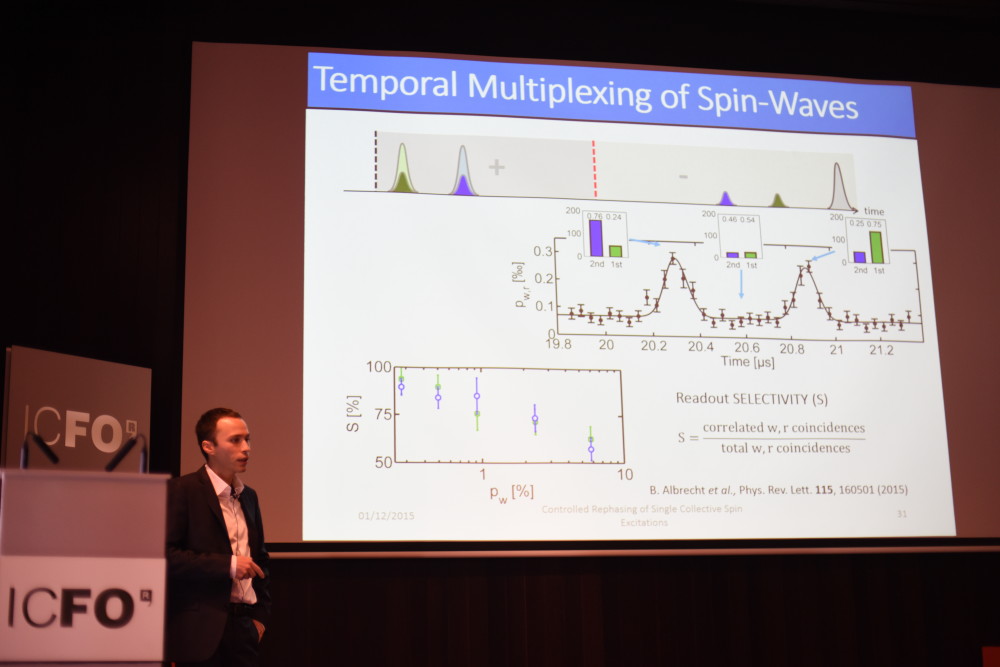1 December 2015


Boris Albrecht has successfully defended his thesis titled “Quantum control of single spin excitations in cold atomic quantum memories”. Boris is the second PhD graduate from our group. We congratulate Dr. Albrecht and wish him success in Copanhagen!
Abstract
Optical quantum memories are important devices in quantum information science. In particular, they are building blocks of quantum repeater architectures that have been proposed to increase the range of quantum communication beyond the limits set by losses in optical fibers. In this thesis, we report experiments with a quantum memory based on cold atoms. We focus on two important aspects relevant for using the memories as quantum repeater nodes: the connectivity to the optical fiber network, and the ability to operate in a time-multiplexed fashion.
The core of the work presented in this thesis was the implementation of a quantum memory based on spontaneous Raman scattering, following the protocol of Duan, Lukin, Cirac and Zoller (DLCZ). The memory is implemented with a cold ensemble of 87Rb atoms loaded in a magneto optical trap. Single collective atomic spin excitations (spin-waves) are created in a heralded manner, before being retrieved by conversion into strongly non-classically correlated single photons. Our system showed measured second-order cross-correlation function values up to 200, an inferred intrinsic retrieval efficiency inside the science chamber up to 44%, and a memory lifetime up to 55 µs. Current realizations of DLCZ quantum memories present several limitations, reducing the maximum practical distance achievable for quantum repeaters based on these systems. We partially addressed two of them. The first one originates from high absorption in optical fibers at the operating wavelength of 780 nm. The second one is that current demonstrations only allow the creation of spin-waves in single temporal modes, limiting the entanglement generation rates in quantum repeaters protocols.
A good solution to alleviate the first limitation is to translate the wavelength of the single photons to the telecom C-band, where absorption is minimal, while preserving their quantum characteristics. For this, we demonstrated an ultra-low-noise solid state photonic quantum interface based on an integrated-waveguide in a non-linear PPLN crystal. We converted heralded single photons emitted by the DLCZ quantum memory at 780 nm to the telecommunication wavelength of 1552 nm. We achieved a maximum signal-to-noise ratio of 80 for a mean input photon number of 1, allowing us to show significant non-classical correlations between the heralding and converted photons via the violation of the Cauchy-Schwarz inequality.
To address the second limitation, we demonstrated the first experimental steps towards the realization of a temporally multiplexed DLCZ-type quantum repeater node. We showed active control of the spin-waves created in our quantum memory by means of an external magnetic field gradient inducing an inhomogeneous broadening of the atomic hyperfine levels. Acting on this gradient allows active dephasing and rephasing of individual spin-waves, enabling spin-wave creation in multiple temporal modes and read out a specific time-bin only. We showed that the active rephasing technique preserves the non-classical statistics of the heralded photons via the observation of anti-bunching. We then created spin-waves in two temporal modes and demonstrated selective read-out of only one of them with a selectivity up to 92%.
All these results pave the way towards the realization of future temporally multiplexed quantum repeater nodes based on the DLCZ protocol.
